Preprint
Article
Historic p87 Is Diagnostic for Lung Cancer Preceding Clinical Presentation by at Least 4 Years
Altmetrics
Downloads
98
Views
52
Comments
0
Submitted:
16 August 2024
Posted:
19 August 2024
You are already at the latest version
Alerts
Abstract
Lung cancer remains the most common cancer worldwide with a limited prognosis despite personalized treatment regimens. Low-dose computed tomography (CT) scanning as a means to early diagnosis has been disappointing due to the high false positive rate. Other non-invasive means of testing need to be developed that offer both timely diagnosis and predict prognosis.
Methods: In the course of stool testing in a large-scale testing of 2,922 patients at increased risk of CRC we were able to ascertain 112 patients documented to have prospectively been diagnosed with lung cancer. Stool and colonic effluents were tested for p87 with anti-adenoma antibody (Adnab-9) reactivity by ELISA and western blot. Survival data were obtained where available. Results: Of 112 cancers, approximately 27.6% were squamous (SSC), 17.9% were adenocarcinoma, 8% small, 6.25% large cell and 3.57% were designated non-small cell cancer (NSCLC), 0.89% indeterminate, 0.89% lepidic spread (1), 3.57% had metastasis and in 31.25% data was unavailable. 49.1% of the lung cancer patients had fecal Adnab-9 testing. Overall, 60% had positive testing compared to 38%, which was significant (OR2.19[1/06-4.53];p=0.045). Cancers with higher lethality were less likely to test positive (approximately, 8.5% each for both small and large cell lung cancers), and higher, 56% with SCC and 25% for adenocarcinoma. 0% NSCLC). In the larger groups overall survival was worse in those testing positive: 474 testing positive versus 844 days in SCC and 54 testing positive versus 749 days in adenocarcinoma patients. Most importantly, the time from a positive test to the clinical diagnosis ranged from 2.72 years for small cell, 3.13 for adenocarcinoma, 5.07 for NSCLC, 6.07 for SSC, and 6.24 for large cell cancer. In excluded cases where cancer in the lung was believed to be metastatic,83.3% of cancers were positive. Conclusions: At a projected real-world sensitivity of 0.60 and specificity of 0.60 and the ability to predate diagnosis by up to 4.7 years overall, this test could help direct lung cancer screening. In addition, the Adnab-9 testing selectively detects worse tumor types (87.5%) and those with worse prognosis amongst the more common, favorable phenotypes thus making early diagnosis possible in those patients who stand to benefit most from this strategy. Metastatic lung cancer also detected by the test should be identified by the follow-up imaging studies and therefore would not be considered to be a major pitfall.
Keywords:
Subject: Medicine and Pharmacology - Oncology and Oncogenics
1. Introduction:
Lung cancer is the most the common cancer worldwide in men and women and incidence is increasing in the developing countries. Early diagnosis with reduced mortality is achievable with low-dose CT scan but false positives and morbidity of follow-up studies threatens to disrupt the screening effort. Biomarkers to select patients at highest risk are available but enthusiasm is lacking due to economic considerations and prospective studies are limited. In addition, despite gains in reduced mortality using novel small molecular weight inhibitors it still remains for most victims, a deadly disease. We describe prospective stool and effluent testing in a cohort of urban patients using a monoclonal antibody Adnab-9 that recognizes p87 a constituent of Paneth cells, an effector of the innate immune system and staining in an unrelated cohort of familial lung cancer patients and control lung tissues from the same geographic location. Recently, we have used blood Ferritin level with p87 recognized by the Adnab-9 monoclonal that recognizes p87, as the denominator for the resultant ratio that we have termed “FERAD”. We believe that the FERAD ratio is an accurate measure of the innate immune system (InImS) activity, particularly in responding to cancer and viral infections [2]. We have also used this ratio to contrast InImS in lung cancer with its frequent concomitant [3], chronic obstructive pulmonary disease (COPD).
2. Methods:
Prospectively, 2,922 American patients in Metropolitan Detroit submitted stool in a CRC prospective screening study from 1996 to 2013. We used an stool ELISA and western blotting as described previously [7] to detect p87, a product of the innate immune system to prospectively detect lung cancer in a cohort of patients at high risk for colorectal cancer. Controls were selected on the basis of criteria of no diagnosed lung, other cancer or family history of cancer. Other criteria used were non-smokers, no alcohol intake and non-diabetic patients. Patients and controls were approximately 50–80 years old and the male to female ratios were similar (5:1 and 10:1). Sixty- seven percent of patients and 45 % of controls were African American. Immunohistochemical (IHC) staining of lung tissues of 28 patients with lung cancer from patients seen at the Karmanos Cancer Institute collected retrospectively and the IHC were performed as described previously [8]. Commercially available lung tissue arrays with malignant and benign tissues were stained with anti-p87 monoclonal Adnab-9 and ELISA of tissue extracts from 3 bronchoalveolar (lepidic spread) cell lines (a kind gift of Dr. Galli Hilman) was performed.
Results: 112 Lung cancers were detected on follow-up, 8.25±5.63years before the clinical diagnosis. These data were available in 52 patients (46%). The sensitivity was 60% vs 38% in 44 controls and the difference was significant (OR2.19[1.06-4.53];p=0.045). In the group who submitted stool samples, 20 were adenocarcinomas; 31 were squamous cell cancers; 9 were small cell; 7 were large cell; 4 were non- small cell; 4 were metastatic; 1 was indeterminate; and 1 had lepidic spread features; data was unavailable in 35 patients. (29%). Patients are summarized in Table 1.
Of these 112 patients, 51 (46%) had prospective stool Adnab-9 binding tests testing. We found that about half the patients ultimately diagnosed with lung cancer had either stool ELISA or Western blot positivity for Adnab-9 compared to 14 patients were alive and 48 had expired (22.6% survival). 74 were black and 37 white and 1 unknown. 101 were male and 9 were females (2 unknown); average age was 63.78±10.82 years at time of enrollment. 49 were actively smoking and 26 were not. Quantitively, data were available in over half the patients: 6 had quit, 24 had <30pyh, 14 <60pyh 12<100pyh and 15>100pyh. 58 had a BMI<28kg/m and 24 were greater where available. 21 did not have a second cancer diagnosis. According to tumor type adenocarcinoma lead in time from test to diagnosis was 10.96±6.41 years (age 57.77±9.43); large cell 4.09±3.39 Years (age 65.20±8.08); non-small cell cancer 4.55±4.20 years (age 65.00±7.53); squamous cell cancer 8.38±6.53 years (age 64.15±11.72); small cell cancer 3.31±3.00 years (age 72.33±7.79) . 9.46± 5.34 years was the lead in time where the type of cancer was unknown (age 65.93±10.4).
Figure 1.
Lead-in Time and Lung Cancer Types.
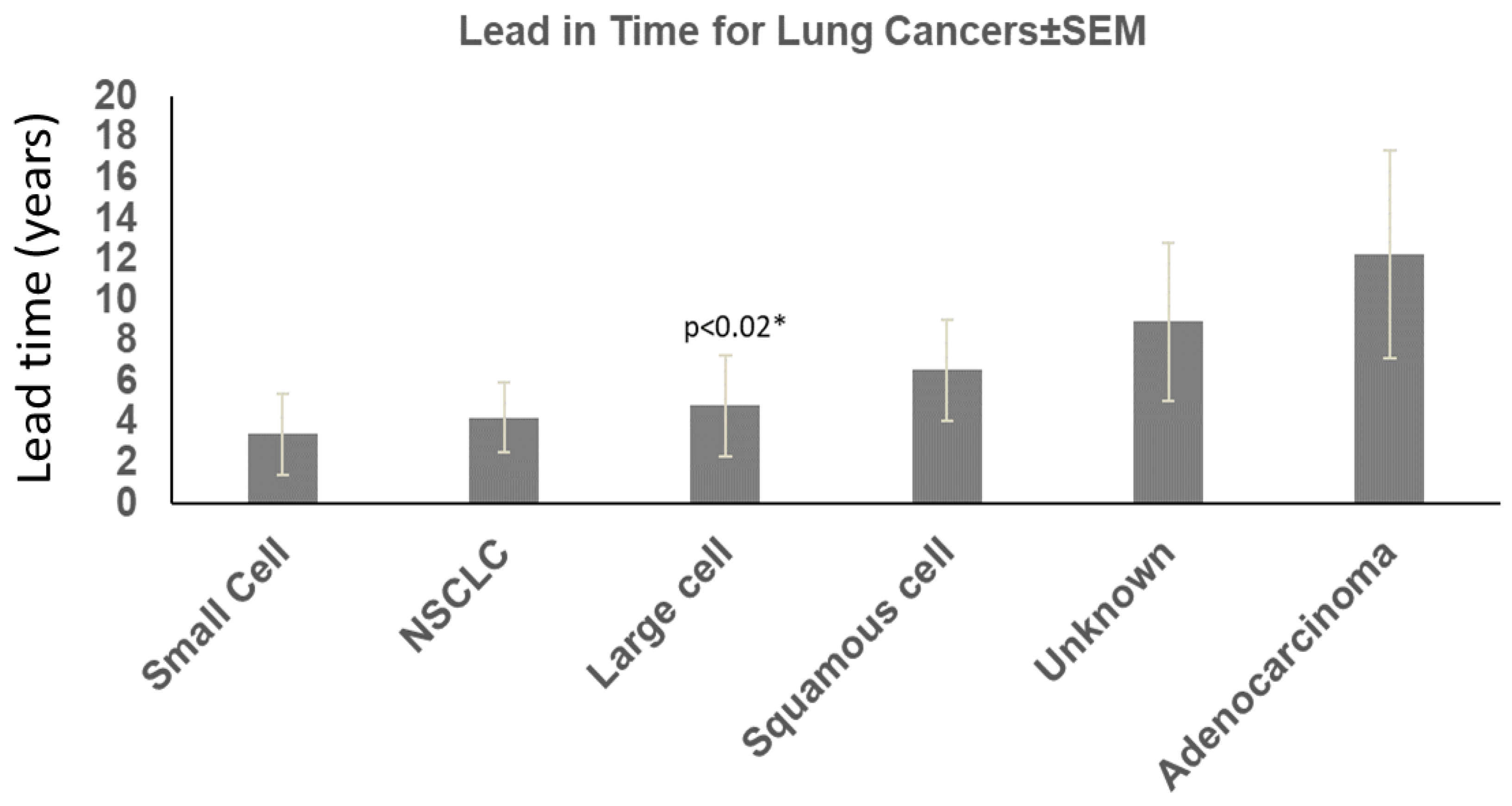
The “*” shows the significance when comparing lead in time for adenocarcinoma versus large cell cancers. The other significant differences between cancer cases and controls were: age where patients with cancer over 50 years of age predominated over control cases (78% versus 62%; 2.16(1.37-3.40) chi-square with Yates correction; Black African ancestry (67 vs 52%;1.83[1.22-2.75]; p<0.005; less obesity (BMI<80m/Kg2 in the lung cancer group (29 vs 51%; 0.39[0.24- 0.64];p<0.0002); smoking 65 vs 36% (3.34[2.05-5.46];p<0.0001); more additional malignancies 81% versus 71% (p<0.037, Yates correction); and family history of lung cancer in 2% versus 0.11% in controls <0.02, 16.69[2.33-119.70] by Fishers Exact test. The results are summarized in Table 1.
Saliva specimens collected before lung cancer diagnosis were reacted with p87 and OSN [9], for innate immune and adoptive immune systems but were not found to be clinically useful when standardized by protein contrast saliva peroxidase activity difference between patients and controls was significantly different despite relatively small numbers. Inherent salivary peroxidase activity in the LC group was significantly lower (OD<0.05/1 µg protein) less (P<0.05) than in controls (64.3% positive). Although not significantly different we did find that Ad-9 bound to saliva of lung cancer patients more that non-lung controls and Cox2 antibody binding using horse-radish peroxidase to detect substrate, showed an inverse relationship (Figure 2).
Figure 2 shows saliva binding of Adnab-9 in slot blots are more sensitive in patient with lung cancer than Cox-2 antibody binding but inferior to historic stool and effluent binding as noted above.
IHC for p87 favors certain phenotypes (Figure 3) and also shares an inverse relation with prognosis in the higher graded tumors (Figure 4). Of seven lung cancer IHC samples, 3 were positive, 4 were negative. Only 1 of 27 normal lung samples were positive (OR11.6[CI1.04-128.97;p<0.049]), see Figure 3 for a summary of the entire IHC group and individual cancers. All of the lung cancer KCI patients had a family history of lung cancer.
Figure 3: Bar Diagram Showing Percentage of Various Lung Cancer Phenotypes Labeling with anti-p87, Adnab-9. Bronchoalveolar (lepidic-spread) and papillary cancers were positive for labeling in over 60%.
Figure 4, Figure 5, Figure 6, Figure 7 and Figure 8 are photomicrographs showing Adnab-9 labeling of representative sections of various forms of lung cancers. Figure 9 depicts survival in patients with positive IHC labeling versus those without.
Figure 4 shows a view of a lung adenocarcinoma with golgi staining and a lepidic form of infiltration. The substate is ethylaminocarbazine (EAC) which when present is reddish-brown in color.
A papillary lung cancer at high power is seen to stain the golgi apparatus with reddish brown substrate but not uniformly.
Dense, focal dark, reddish p87 cytoplasmic deposits are seen in this invasive focus of NSCLC with a fibroblastic response.
The figure shows golgi staining in an adenocarcinoma with a less fibrocystic response.
Figure 8 shows that while the NSCLC cancer cells are positive most of the non-cancer tissue does not take up the antibody.
The positive cases had on average 8.3 months survival (one case is still alive and un-staged now, one had local disease, one distant disease) while the negative cases averaged 23 months of survival, depicted in Figure 8, (two with regional disease and 2 with distant disease)
Figure 9: A Bar Diagram showing Survival Times of 51 Lung Cancer Patients, Formalin’ Fixed and Paraffin Embedded Slides, Staining for p87 (positive) and those without (negative).
When comparing primary lung cancer patients who had negative stool testing (n=25) to those with positive testing (n=26) there were no differences in demographics, or survival (p=0.35). Significant differences were seen in historic ferritin levels (358±314 versus 149±129;p<0.034). Higher levels of native antigens in extracts of colonoscopy biopsies were found in the cecum and ascending colon in patients with negative p87 stool tests (cecum 0.132±0.014 versus 0.055±0.031; p<0.035 and ascending colon 0.203±0.059 versus 0.042±0.023; p<0.008) suggestion a lack of shedding from the right side of the colon that harbors Paneth cells reflected in the stool findings. The ratio of historic blood ferritin:fecal p87 (FERAD ratio) thought to reflect the activity of the InImS was found to be commensurately high in patients with very low fecal p87 and higher ferritin levels(179,882±302,992 versus 2,987±3492; P<0.048). The patients with a negative stool and higher FERAD levels tended to survive longer that those with positive p87 stools but lower FERAD indices (10.6±4.8 versus 7.3±4.4 years, p=0.35). The results are summarized in Table 3.
The interrelationship between p87 staining and lead-in time is quite complex and appears to be biphasic (Figure 8). The 2 axes interest with the coordinates for squamous cell cancer at the intersection (oval symbol) and a strong trend to a direct correlation of adenocarcinoma (faceted square) and large cell carcinoma (triangle) and a highly significant inverse correlation with NSLC at the upper end (pentagram) and small cell cancer (rectangle) at the lower end. This suggests that for some p87+ cancers prognosis is better and for others, worse. This is not unusual for lung cancers [11] where morphologic characteristics are of profound importance for type of treatment and hence prognosis. Certain assumptions were made that p87 % stain was uniform for type of cancer since the data was derived from 2 different populations of patients.
Figure 10. symbols show a solid block square for adenocarcinoma,  ; solid rectangle for NSCLC,
; solid rectangle for NSCLC,  ; a solid circle for squamous cell,
; a solid circle for squamous cell,  ; ;a solid triangle for a large cell,
; ;a solid triangle for a large cell,  ; a solid pentagram for small cell,
; a solid pentagram for small cell,  .
.
 ; solid rectangle for NSCLC,
; solid rectangle for NSCLC,  ; a solid circle for squamous cell,
; a solid circle for squamous cell,  ; ;a solid triangle for a large cell,
; ;a solid triangle for a large cell,  ; a solid pentagram for small cell,
; a solid pentagram for small cell,  .
.
Figure 11 shows increase of binding with increase of protein content in 3 Lepidic Spread Lung Adenocarcinoma cell lines. H1650 p87 binding is equivalent to the positive control (data not shown).
Adnab-9 treated lepidic bronchoalveolar cancer cell lines is antiproliferative further supporting our observations (data not shown).
We found that there was a statistically significant difference between the FERAD ratio in patients with COPD and controls (Figure 12).
There is a statistical difference between COPD patients and controls (p<0.011) in Figure 12. Interestingly there is also a statistically significant positive correlation between survival in lung cancer patients both primary and metastatic, and those with COPD and controls (Figure 13).
From left to right the dots designate cancer metastatic (Mets) to lungs; primary lung cancer; COPD patients and controls.
3. Discussion:
p87 can detect cancers up to 12 years before they are diagnosed with reasonable sensitivity and specificity for most common forms of lung cancer. This strategy can select out patients at high- risk who could undergo radiologic imaging leading to a much earlier diagnosis that could currently achieved. The p87 biomarker appears to identify the patients with a poorer prognosis and thus aiding in detection in these tumors at a very early stage will allow for effective intervention. Hopefully this approach will reduce mortality from this common organ cancer site. p87 staining suggests a differential stain in lung cancer as opposed to normal tissues. Conceptually, Adnab-9 recognizes the p87 antigen [8], a constituent of putatively activated pulmonary type 2 pneumocytes and particularly lung cancer cells. The p87 antigen is likely shed into sputum and swallowed may represent a useful potential tumor marker detectable by the Adnab-9 stool test. Of note is the fact that both α- Defensin5 and p87 are both Paneth cell secretory products yet the former is not expressed in the lung. However, β-defensins are secreted in the lung and earlier studies did find an cancer association of overexpression in about 40-50% in common forms of lung cancer but no association of human β-defensins (HBD) type 1.2 and 4 mRNA levels with histological type, tumor grade or stage of disease or suman levels of the peptide [12]. Earlier, others [13] had shown a correlation of HBD1 and 2 with lung cancer with an estimated sensitivity of 76.4% and specificity of 94% pre-surgery but no prospectively with respect to cancer diagnosis which was known at the time of venesection. A later summary of the data for HBD1,2 and 3 cautioned against generalization with different cancer types but allowed the association with tumor progression [14]. The same caveats may be applied to p87 but the lead-in time for diagnosis is for now, unparalleled. Despite a similar cellular source as defensins, p87 outside of the lung does not usually label cancers but has been shown to be retrospectively diagnostic and prognostic in stool in both colorectal cancer (CRC), IPMN pancreatic subtype, and gastric cancer [3,15,16,17,18] and prospective in the common form of pancreatic cancer [19] where the lead-in time was 2.3 years. This and other work conform to biomarker standards proposed in 2018
[11] such as objective measuring to which our standardized ELISA aligns, evaluated as usual biological process (product of the innate immune system); influence clinical decisions minimizing harm (p87 estimation is non-invasive, risk-free, and predictive); the biomarker must be stable and reproducible (p87 is stable for more than 10years [19] in cold storage with a high correlation coefficient); must be sensitive and specific (while p87 is only moderately sensitive and specific ~60% for both), its lead-in time more than compensates but the algorithm for use has thus far not been developed definitively). Adnab-9 has been confirmed to be prognostic by an independent laboratory [20], does not disrupt workflow and reduces cost and harm. p87 is an inexpensive, cost-effective ELISA-based test and envisaged follow-up would be down to top to minimize costs by allying the stool test with salivary peroxidase to increase specificity and both could be sent in the mail on fecal occult blood cards which has been shown to be acceptable and effective in large-scale [10] CRC screening trials) . The medium should be convenient such as lung sources (exhaled breath or sputum) but blood [21], saliva and urine are also convenient (p87 could be co-opted onto the organ specific neoantigen (OSN) urine test [9] which we also used in this study in limited numbers (data not shown). Low dose computerized tomographic (LDCT) screening has been shown to reduce disease-specific mortality from lung cancer by 20% and all-cause by 7% but this has come at a cost of poor specificity with one quarter of screened patients exhibiting lesions with 96% proving to be false-positive associated with many drawbacks [22]. They conclude that new modalities are promising but do not satisfy current goals to qualify as biomarkers of proven utility.
There are many pitfalls even with morphology used to characterize the type of lung cancer, for example, lepidic growth patterns a more unusual characteristic of invasive mucinous lung adenocarcinoma (Figure 12) can be mistaken for metastatic pancreatic cancer [23,24]. Molecular testing, sometimes yielding similar results for both types of cancer, may confound the differential diagnosis [25]. Table 1 shows interesting differences, some can be explained by lifestyle differences such as smoking and effects of being overweight but others are more challenging. Fewer “other cancers” is somewhat counter-intuitive. Black ethnicity is significantly more prevalent but this may be a normal inner-city distribution. The lethality of lung cancer despite significant advances is still imposing. Family history differences may suggest familial commonality of risk factors.
While Table 2 shows no increased mortality based on p87 expression the differences may be explained by increased shedding particularly from the right colon where the colonic Paneth cells are distributed. If the numbers could be increased the current trend to increased mortality in p87+ patient may become significant. The innate immune system as defined by the FERAD ration suggests a significant reduction in p87+ patients which may have associated adverse events. The H1650 cell line has a EGFR mutation in exon 19 but is very resistant to EGFR-directed inhibitor treatment despite seeing responses in other cell lines showing the same mutation [26]. It does express p87 and using anti-p87 Adnab-9 monoclonal, proliferation is reduced. This monoclonal should be considered in treatment trials of cancers with positive EGFR mutations yet showing anti-EGFR resistance.
4. Conclusion:
The role of COPD has been established as a concomitant of lung cancer and we show in figure 12, elevated FERAD ratios in both COPD and lung cancer patients supporting this notion that InImS reactivity correlates with both diseases equally. In Figure 13 we also show a direct correlation of FERAD with survival. We thus can diagnose lung cancer earlier by fecal p87 shedding and may be able also to prognosticate by serially following the FERAD ratio as a biomarker.
In addition, with the advent of a new monoclonal (Dupilumab) that blocks the shared receptor for Il-4 and IL-13, used in COPD patient with type 2 inflammation, the inflammation driving both COPD and lung cancer may help prevent the disease [27]. Conceivably changes could be detected with the FERAD ratio and help manage these diseases. These data support the notion that accessible, early non-invasive testing combined with effective follow-up modality may be able to reduce mortality from lung cancer the world’s most frequent cancer, with reduced adverse events as the desirable outcome.
Acknowledgments
The authors wish to emphasize that the opinions expressed in this publication are not necessarily those of the VHA or the US Federal Government. The data contained herein was produced by Federal employees and are therefore in the public domain. This research was funded in part by the Biomedical Laboratory Research and Development, VA Office of Research and Development, (MT);by a grant from the Kaiser Permanente Research Foundation grant-in- aid (MT); and an intramural seed-grant from Central Michigan University College of Medicine (MT). We wish to express our gratitude to Dr. Volkan Adsay, Dr. Ann Schwartz, Dr. Nadeem Ullah, and Dr. Michael Lawson. Thanks also, to our librarians Diane Piskorowski, Susanna Sheltraw, Akilah Wood, and Andrea Rogers-Snyr. The authors do not report any conflict of interests. This paper is dedicated to the memory of Dr. Shivkumar Prabu and Zalman Bor.
References
- Chakraborty RK, Sharma S. Bronchoalveolar Cancer. [Updated 2020 Mar 24]. In: StatPearls [Internet]. Treasure Island (FL): StatPearls Publishing; 2020 Jan-. Available from: https://www.ncbi.nlm.nih.gov/books/NBK513281/.
- Tobi, M.; Bluth, M.H.; Rossi, et al. In the SARS-CoV-2 Pandora Pandemic: Can the Stance of Premorbid Intestinal Innate Immune System as Measured by Fecal Adnab-9 Binding of p87:Blood Ferritin, Yielding the FERAD Ratio, Predict COVID-19 Susceptibility and Survival in a Prospective Population Database? Int. J. Mol. Sci. 2023, 24, 7536. [CrossRef]
- Qi C, Sun SW, Xiong XZ. From COPD to Lung Cancer: Mechanisms Linking, Diagnosis, Treatment, and Prognosis. Int J Chron Obstruct Pulmon Dis. 2022 Oct 17;17:2603-2621. PMID: 36274992; PMCID: PMC9586171. [CrossRef]
- Trivedi NN, Arjomandi M, Brown JK, et al. Risk assessment for indeterminate pulmonary nodules using a novel, plasma-protein based biomarker assay. Biomed Res Clin Pract 2018. [CrossRef]
- Weiss G, Schlegel A, Kottwitz D, et al. Validation of the SHOX2/PTGER4 DNA methylation marker panel for plasma-based discrimination between patients with malignant and nonmalignant lung disease. J Thorac Oncol 2017;12:77–84. [CrossRef]
- Ooki A, Maleki Z, Tsay JJ, et al. A panel of novel detection and prognostic methylated DNA markers in primary non- small cell lung cancer and serum DNA. Clin Cancer Res 2017;23:7141–52. [CrossRef]
- Tobi, M.; Elitsur, Y.; Moyer, M.P.; Halline, A.; Deutsch, M.; Nochomovitz, L.; Luk, G.D. Mucosal origin and shedding of an early colonic tumor marker defined by Adnab-9 monoclonal antibody. Scand. J. Gastroenterol. 1993; 28: 1025–1034. [CrossRef]
- Tobi M, Hatfield J, Adsay V, et al. Prognostic Significance of the Labeling of Adnab- 9, in Pancreatic Intraductal Papillary Mucinous Neoplasms. International Journal of Pancreatology 2001;29:139-48. [CrossRef]
- Tobi M, Darmon E, Rozen P, et al. Urinary organ specific neoantigen-A potentially diagnostic test for colorectal cancer. Dig Dis and Sci 1995;40:1531-7. [CrossRef]
- Martin Tobi, Yosef Y. Tobi, Fadi Antaki, MaryAnn Rambus, Michael Lawson. Preliminary data of a stool test for lung cancer from a prospective study [abstract]. In: Proceedings of the American Association for Cancer Research Annual Meeting 2018; 2018 Apr 14-18; Chicago, IL. Philadelphia (PA): AACR; Cancer Res 2018;78(13 Suppl):Abstract nr 4519. [CrossRef]
- Seijo LM, Peled N, Ajona D et al. Biomarkers in lung cancer screening: Achievements, promises and challenges. J Thoracic Oncol 2018;14:343-357. [CrossRef]
- Shestakova T, Zhuravel E, Bolgova L, et al. Expression of human beta-defensins-1,2, and 4 mRNA in human lung tumor tissue: A pilot study Exp Oncol 2008;2:153-156.
- Arimura Y, Ashitani J-I, Yanagi et al. Elevated serum β-defensins concentrations in patients with lung cancer. Anticancer Research 2004;24:4051-8.
- Gosh SK, McCormick TS and Weinberg A. Human β-defensins and cancer: Contradictions and common ground. Front. Oncol. 2019;9:341. [CrossRef]
- Yuan M, Xhang X-P, Leu Y-L, Xu Y, Ullah N, Lawson M, Tobi M: Fecal Adnab-9 Binding as a Risk Marker for Colorectal Neoplasia. Cancer Letters 235;48-52, 2006. [CrossRef]
- Yuan M, Zhang XP, Tobi M.: ”GP87 as the tumor marker for gastric precancerous conditions.” Chinese Journal of Oncology (suppl) 17:136-8,1995.
- Qiao S, Yuan M, Liu Y-L, Lin X-S, Zhang X-P and Tobi M.: Detection of Gastric Cancer and Pre- malignant Lesions by a Novel Marker GP87 using Monoclonal Antibody Adnab-9. Cancer Epidemiology, Biomarkers and Prevention.2003; 12: 1095- 1099.
- Tobi M, Weinstein D, Kim M, et al. Helicobacter pylori Status May Differentiate Two Distinct Pathways of Gastric Adenocarcinoma Carcinogenesis. Curr Oncol. 2023 Aug 29;30(9):7950- 7963. PMID: 37754493. [CrossRef]
- 19. Tobi M, Kim M, Weinstein DH, et al. Prospective markers for early diagnosis and prognosis of sporadic pancreatic ductal adenocarcinoma. Dig Dis Sci. 2013;58:744-50. Epub 2012 Sep 22. [CrossRef]
- Bhatavdekar JM, Patel DD, Chikhlikar PR, et al. Molecular markers are predictors of recurrence and survival in patients with Dukes B and Dukes C colorectal adenocarcinoma. Dis Colon Rectum. 2001;44:523-33. PMID: 11330579. [CrossRef]
- Chu GCW, Lazare K, and Sullivan F. Serum and blood-based markers for lung cancer screening: a systematic review. BMC Cancer (2018) 18:181. [CrossRef]
- Mehta HJ, Mohammed TL, Jantz MA. The American College of Radiology Lung Imaging Reporting and Data System: Potential Drawbacks and Need for Revision. Chest. 2017 Mar;151(3):539-543. Epub 2016 Aug 10. PMID: 27521737. [CrossRef]
- Rosenblatt MB, Lisa JR, Collier F. Primary and metastatic broncho-alveolar carcinoma. Dis Chest 1967;52:147–152. [PubMed: 6068432].
- Yatabe Y, Dacic S, Borczuk AC, et al. Best Practices Recommendations for Diagnostic Immunohistochemistry in Lung Cancer. J Thorac Oncol. 2019; 14: 377–407. [CrossRef]
- Ritterhouse LL, Vivero M, Mino-Kenudson M, et al. GNAS mutations in primary mucinous and non-mucinous lung adenocarcinomas. Mod Pathol 2017;30:1720–1727. [PubMed: 28776576]. [CrossRef]
- Choi, Y.J., Rho, J.K., Jeon, Bs. et al. Combined inhibition of IGFR enhances the effects of gefitinib in H1650: a lung cancer cell line with EGFR mutation and primary resistance to EGFR-TK inhibitors. Cancer Chemother Pharmacol 66, 381–388 (2010). [CrossRef]
- Bhatt SP, Rabe KF. Hanania NA, et al. Dupilumab for COPD with Type 2 Inflammation Indicated by Eosinophil Counts. N Engl J Med 2023; 389:205-214. [CrossRef]
Figure 2.
Adnab-9 and anti-Cox2 Binding to Saliva.
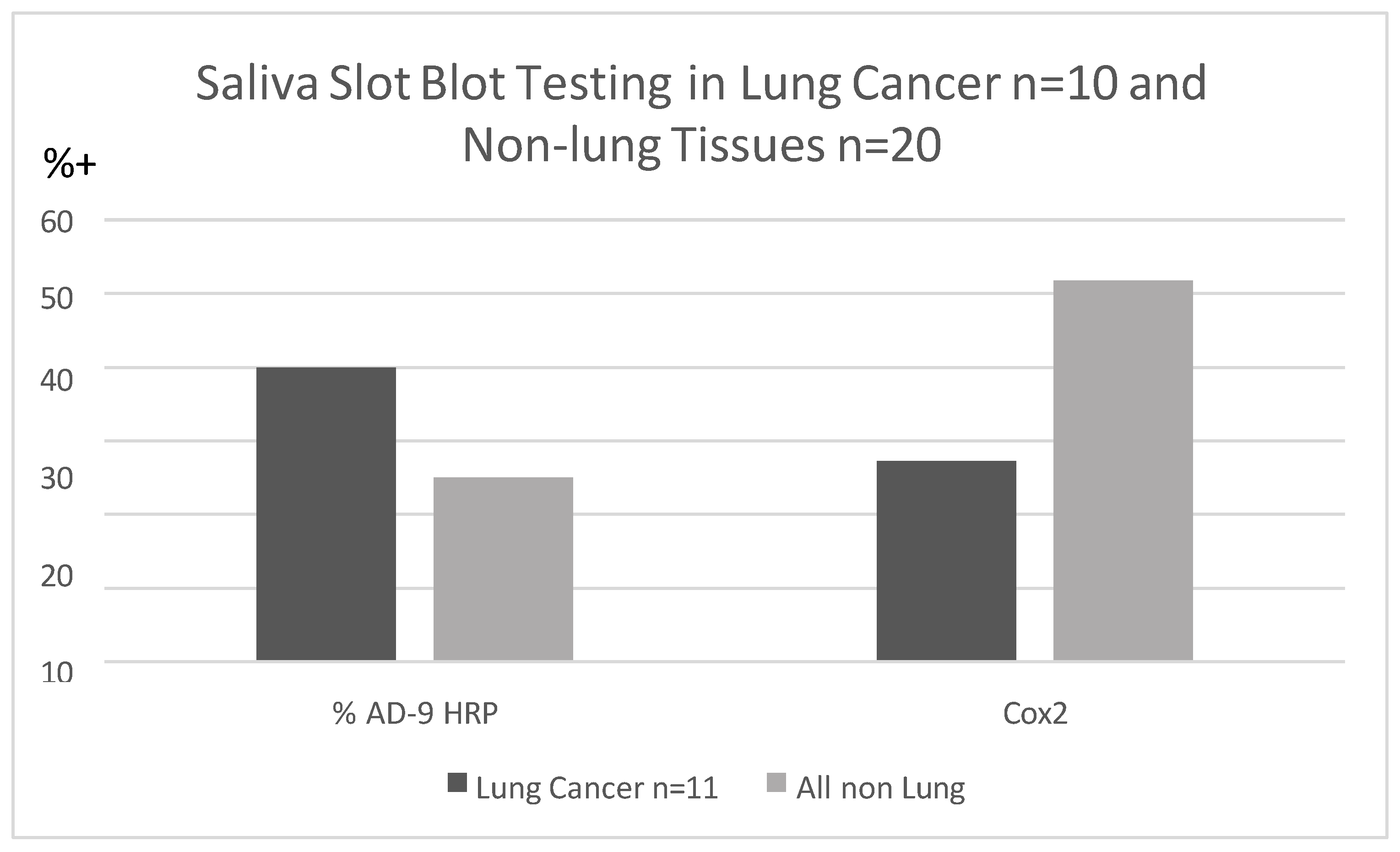
Figure 3.
Adnab-9 IHC Labeling of Lung Cancer Slides.
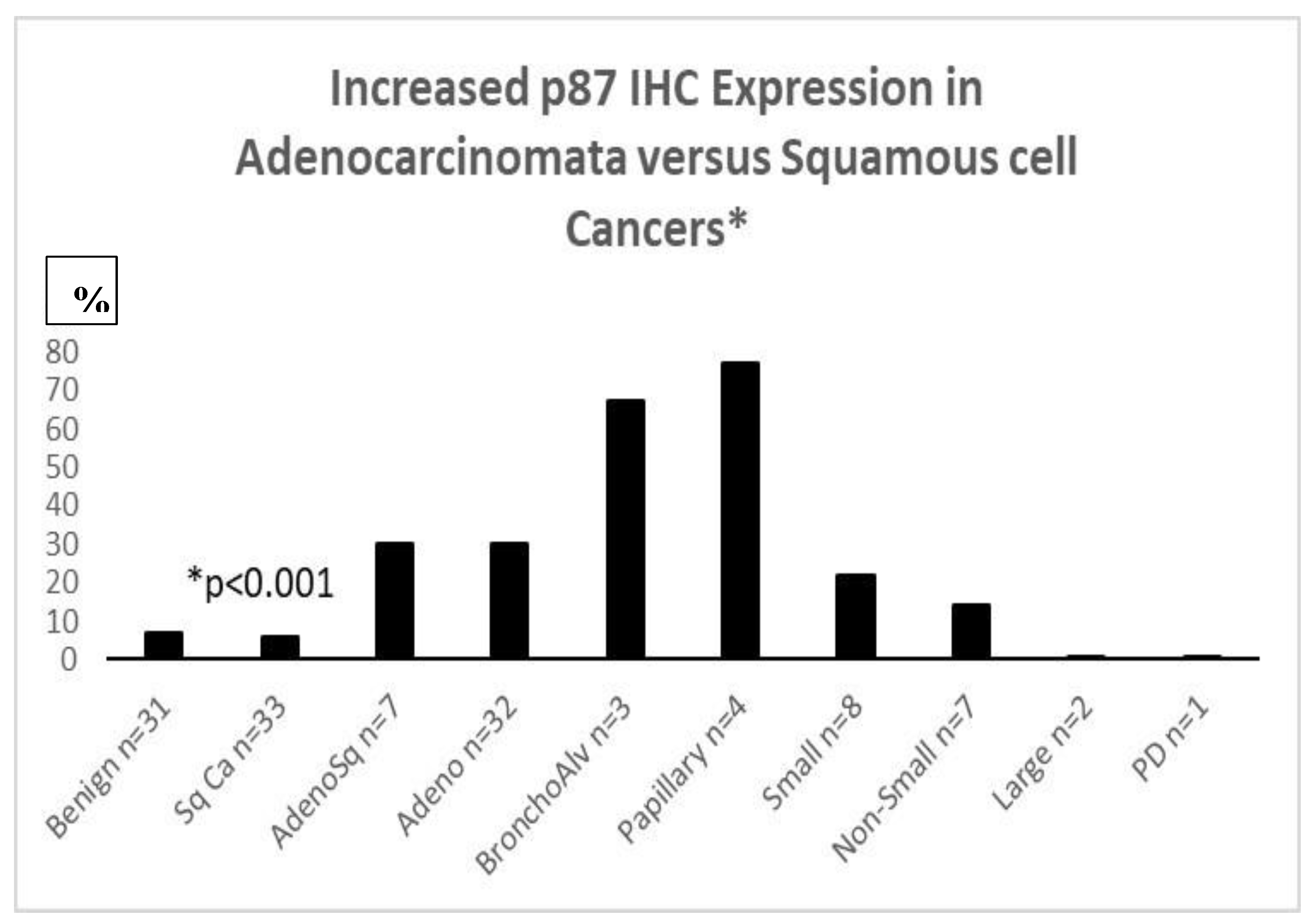
Figure 4.
Bronchoalveolar Lepidic Spread Lung Carcinoma with Perinuclear p87 IHC.
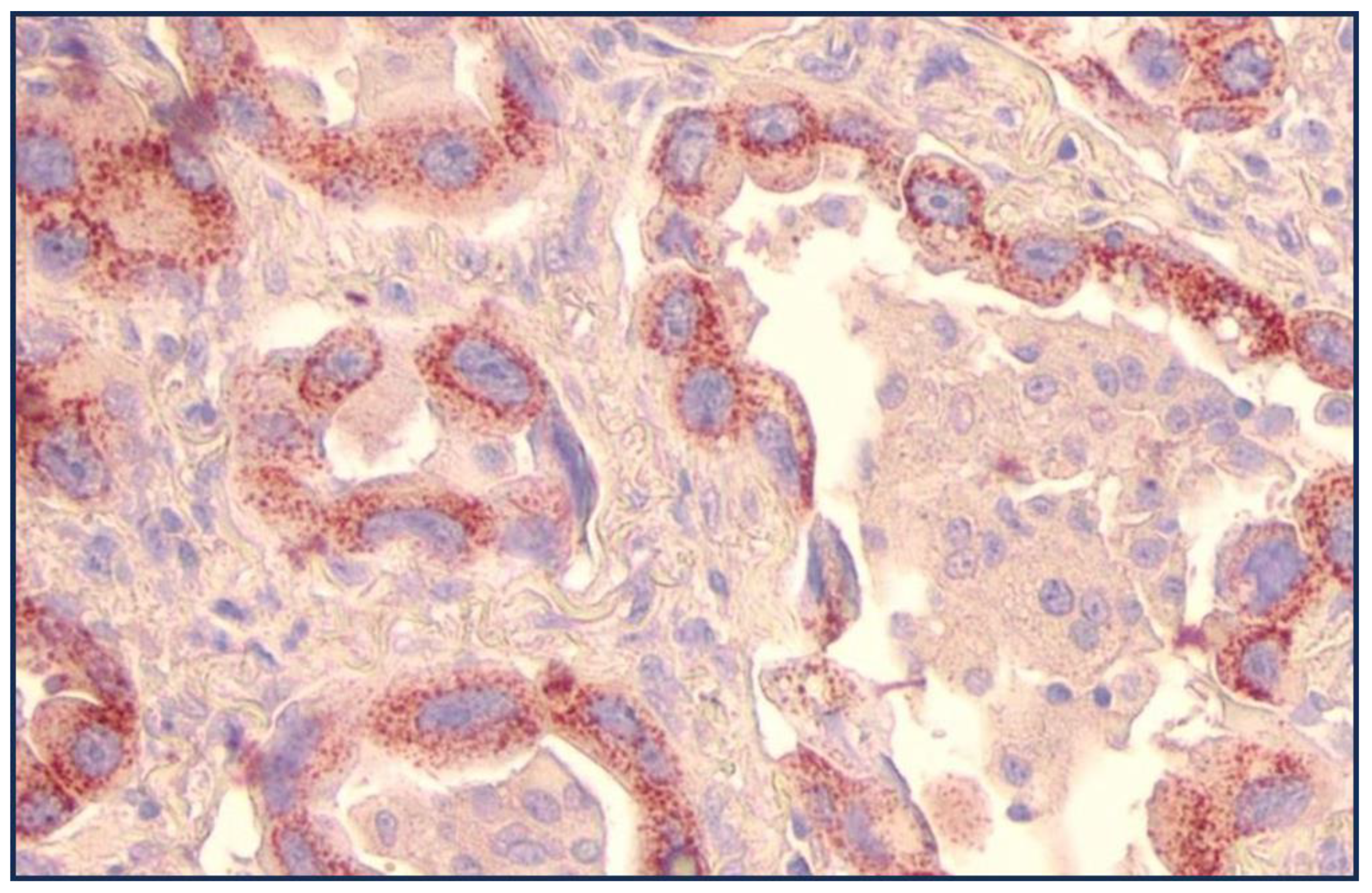
Figure 5.
Papillary Lung Cancer with 1+ Golgi Labeling with Adnab-9 Monoclonal Antibody.
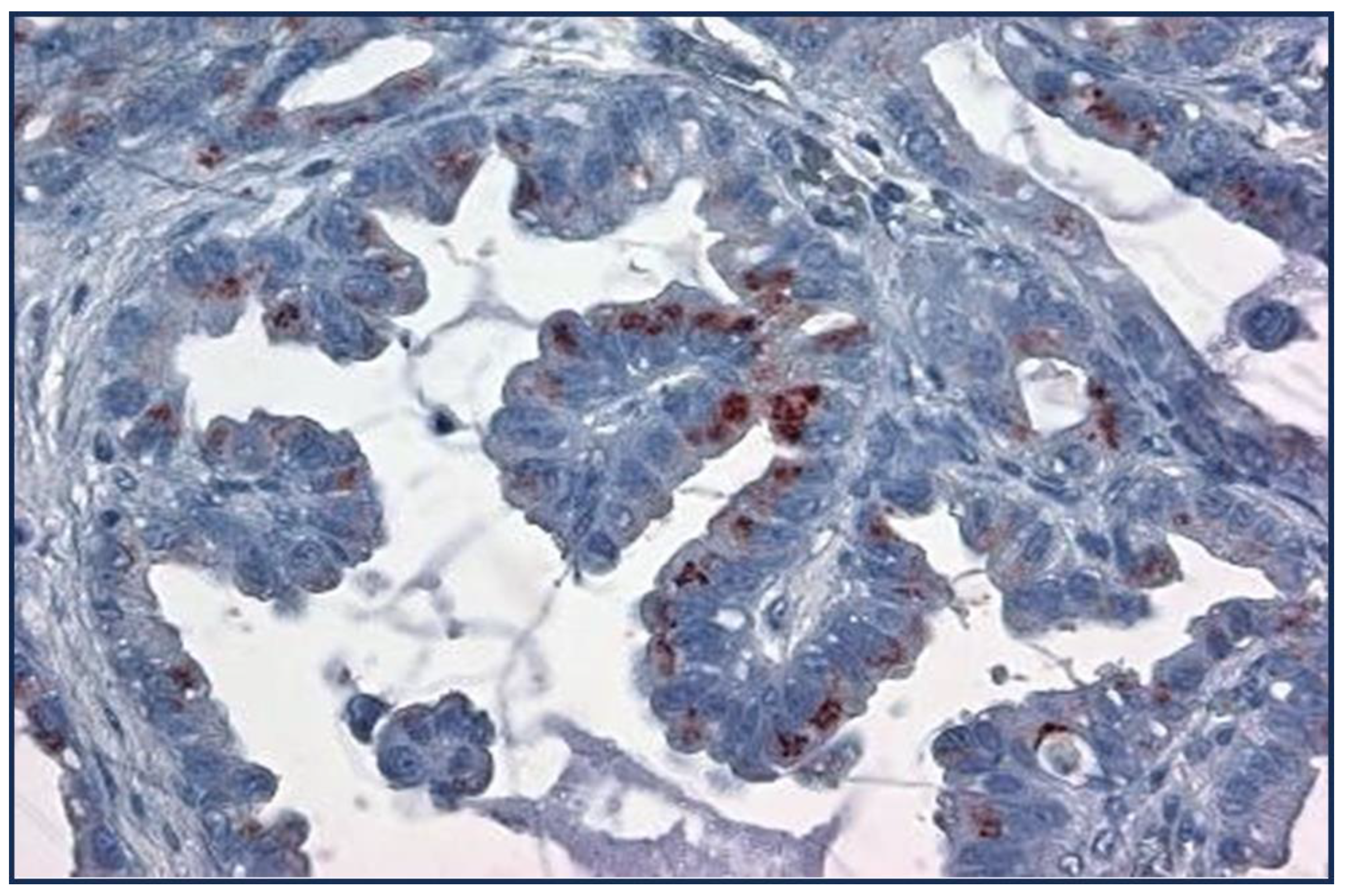
Figure 6.
3+ Golgi Staining of Lung Cancer Cells with Adnab-9.
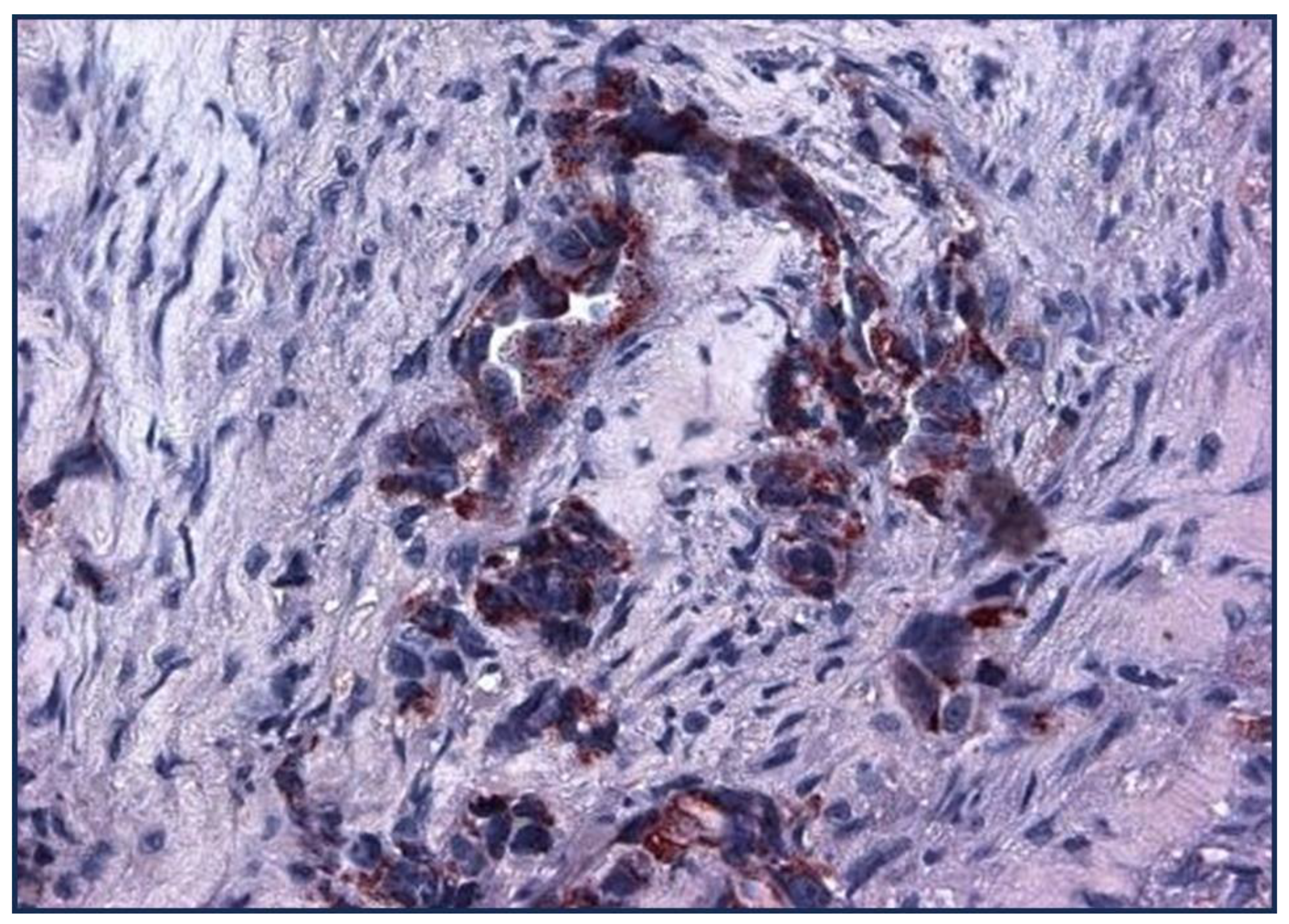
Figure 7.
Lung Cancer Cells staining with Adnab-9.
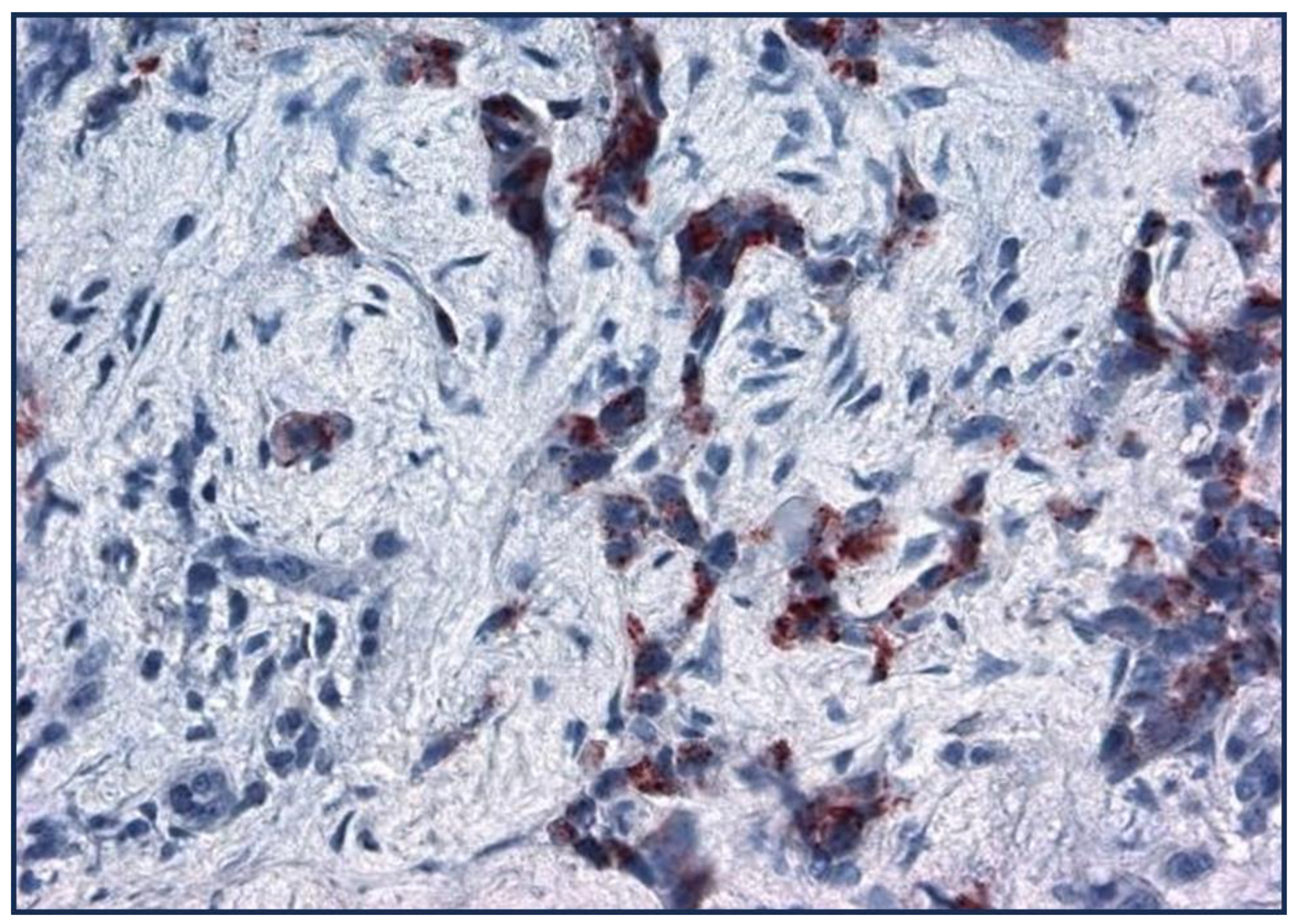
Figure 8.
Golgi Staining of p87 in Adenocarcinoma Lung Cancer Cells.
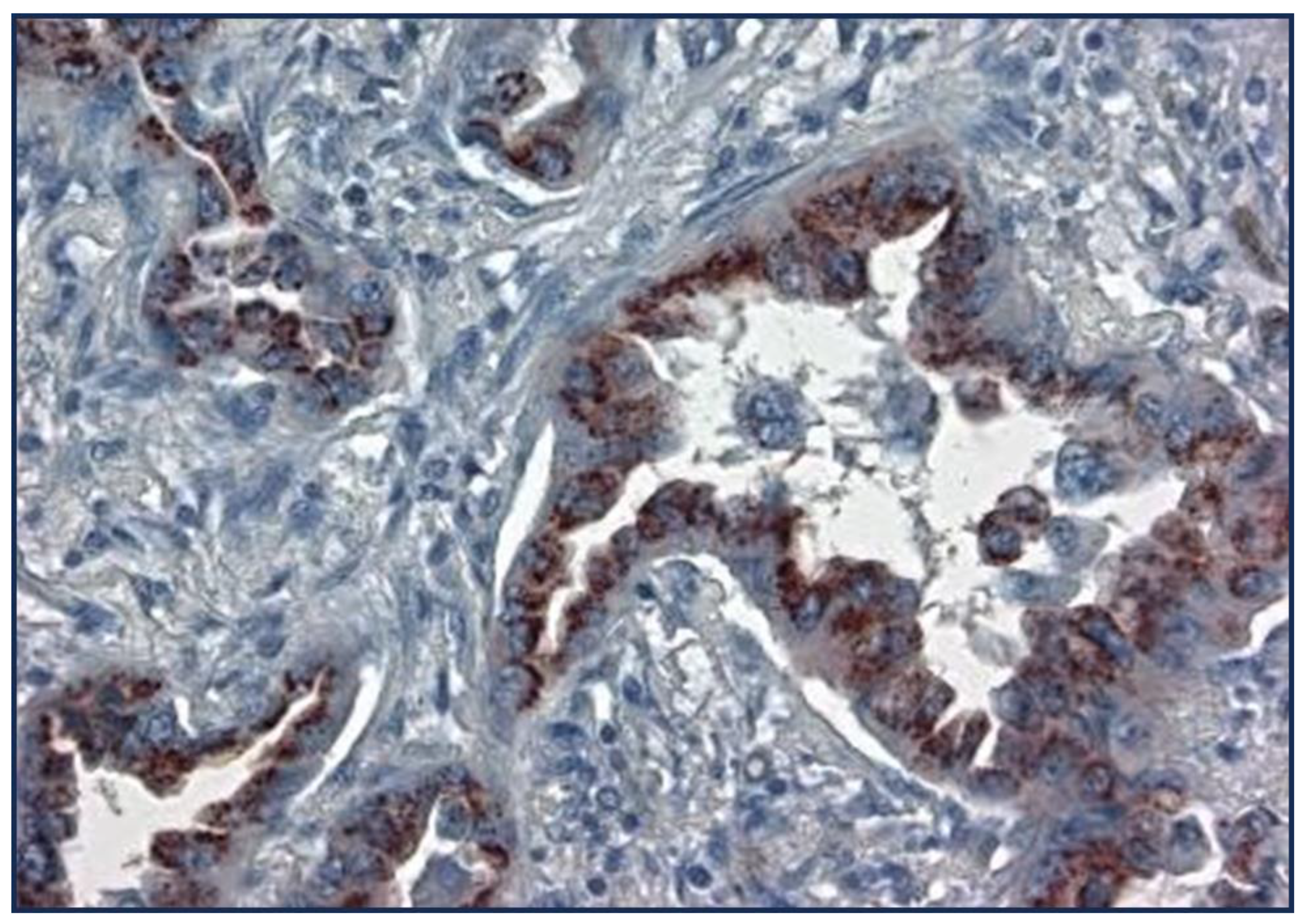
Figure 9.
shows a better survival for patients (though not significant) where the lung cancer tissues stain negatively.
Figure 9.
shows a better survival for patients (though not significant) where the lung cancer tissues stain negatively.
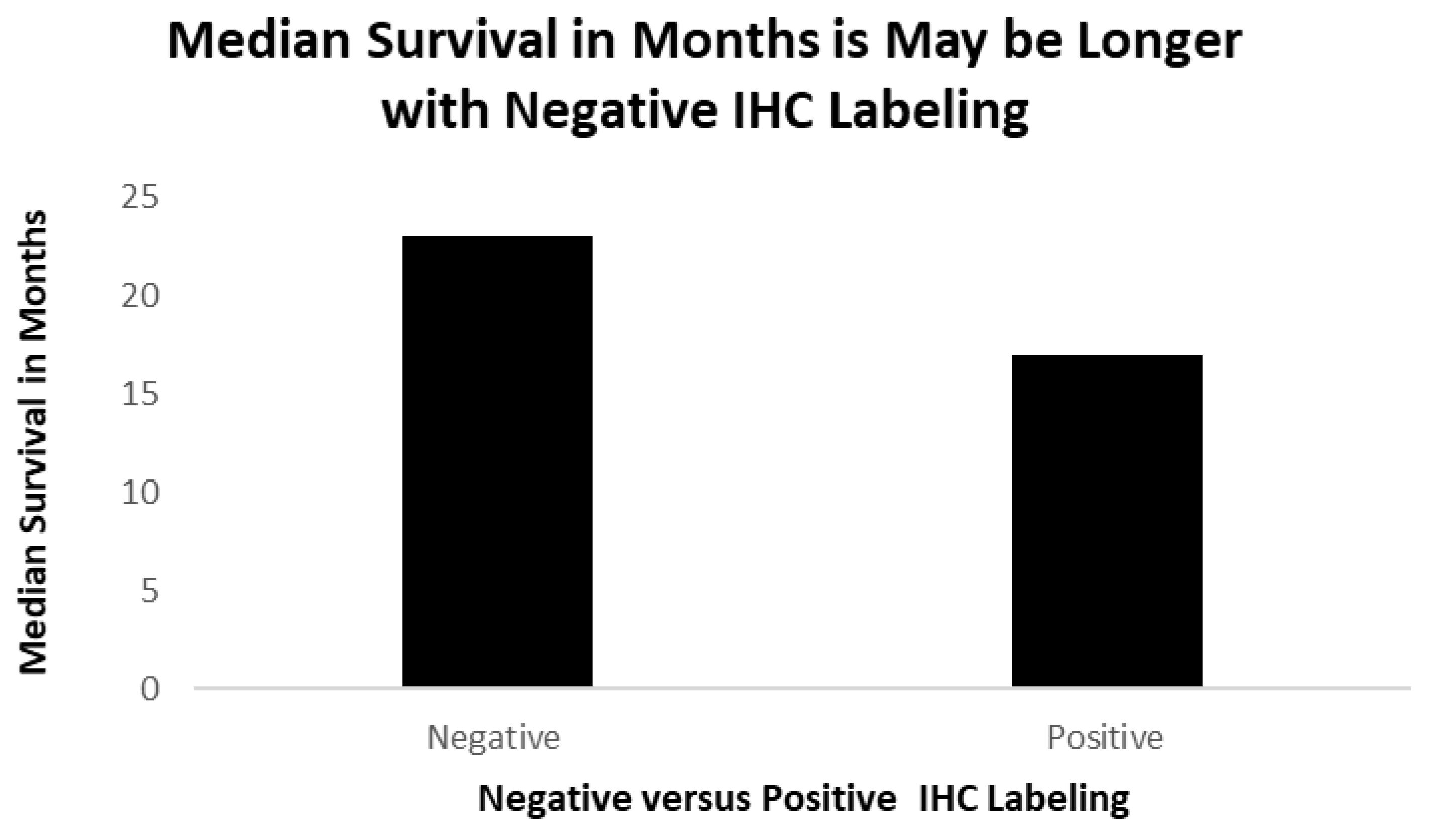
Figure 10.
Complex relationship of Lead-in time and % p87 staining.
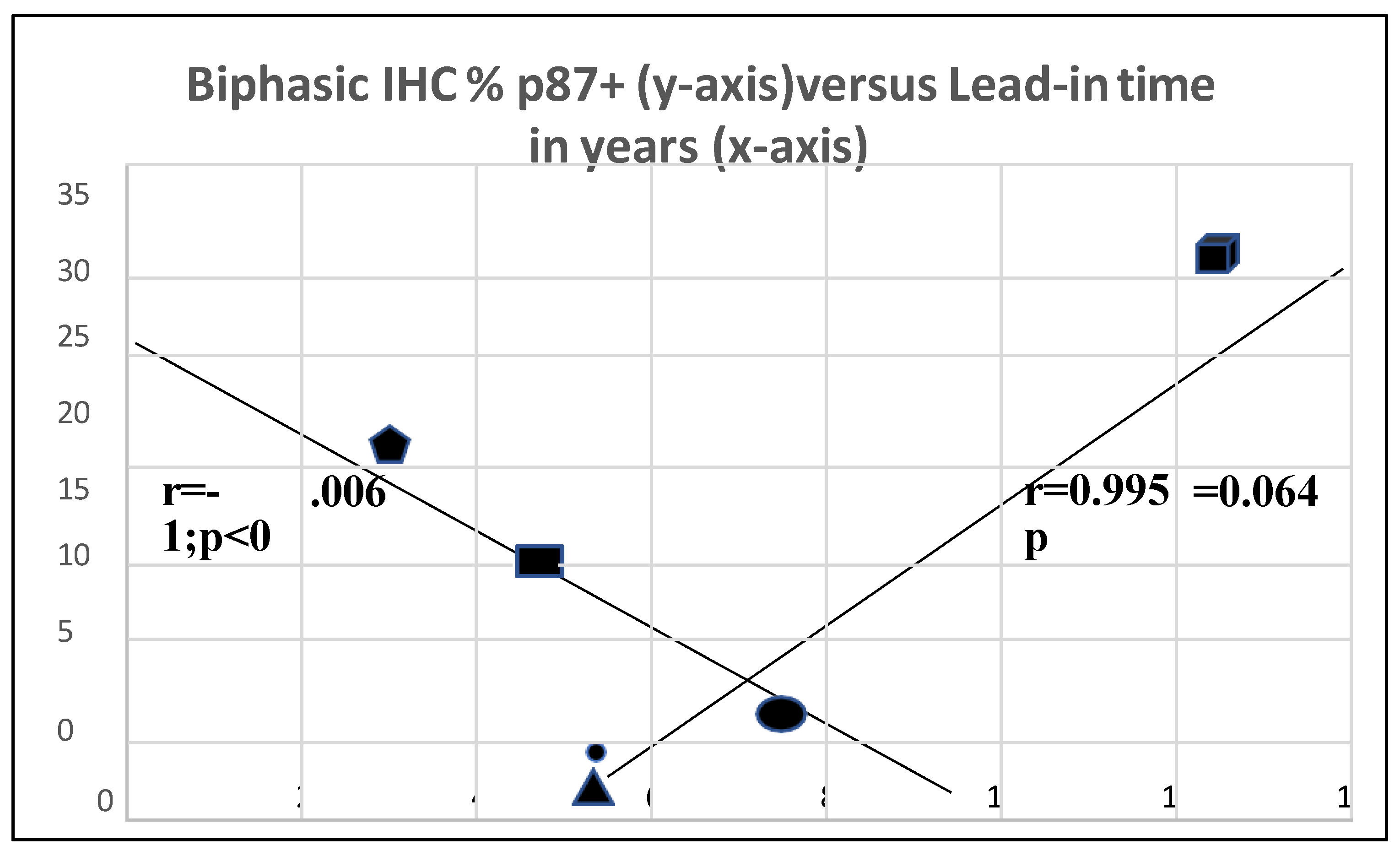
Figure 11.
Three Lepidic Spread Lung Adenocarcinoma Cell Lines were Shown to be ELISA Positive.
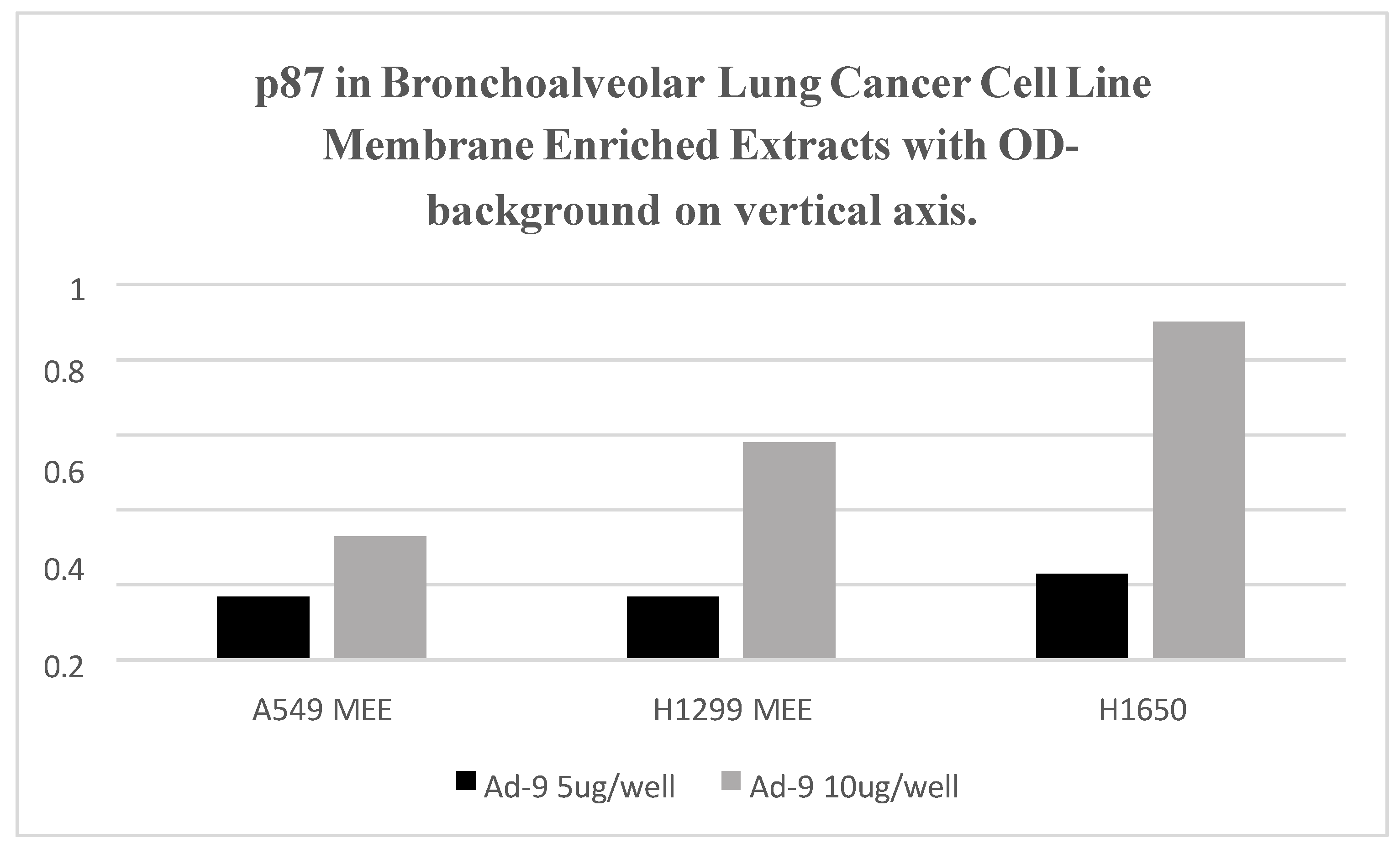
Figure 12.
is a bar diagram that depicts the FERAD ratio is disease states and controls.
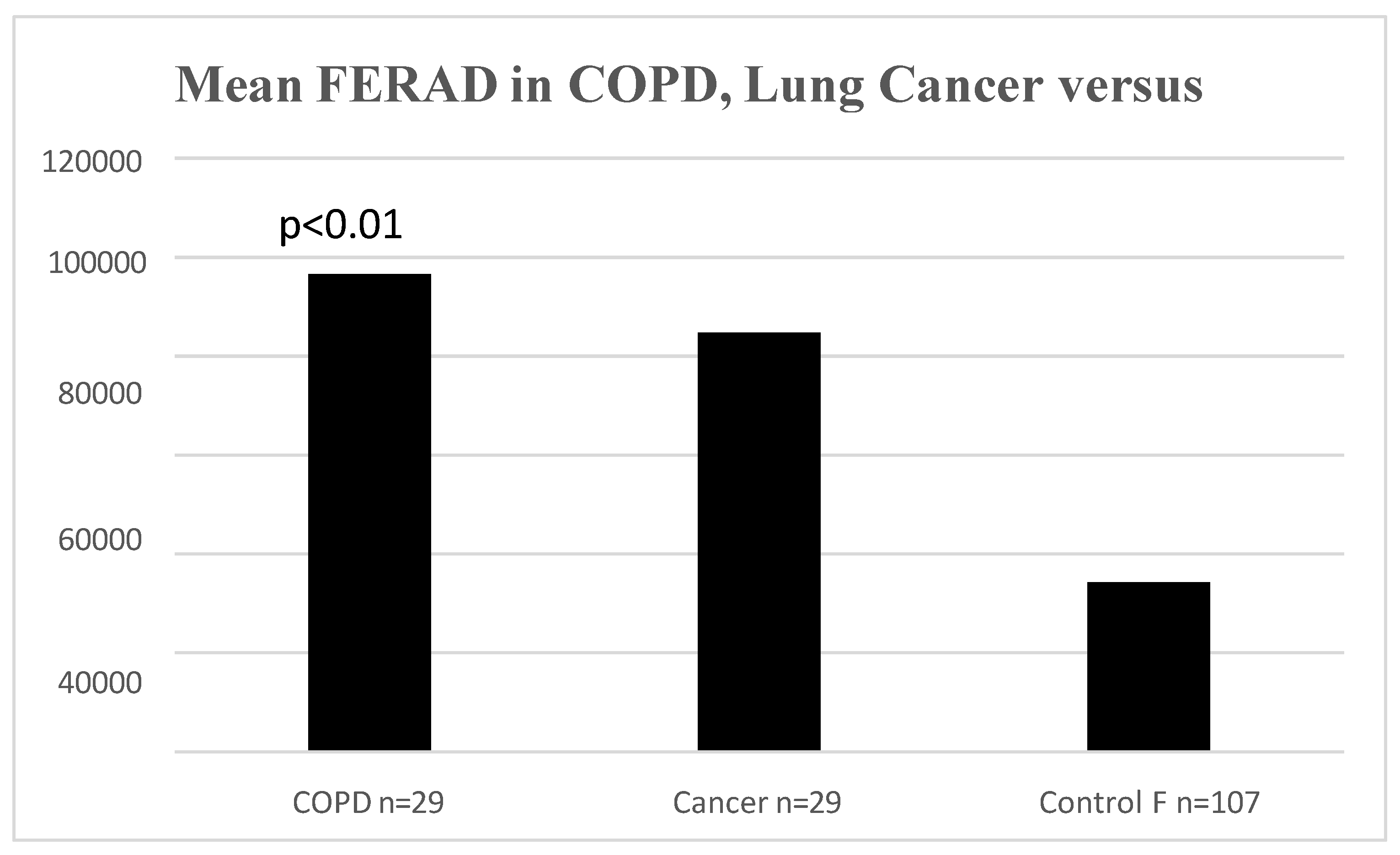
Figure 13.
A positive correlation curve of survival versus FERAD ratio is depicted.
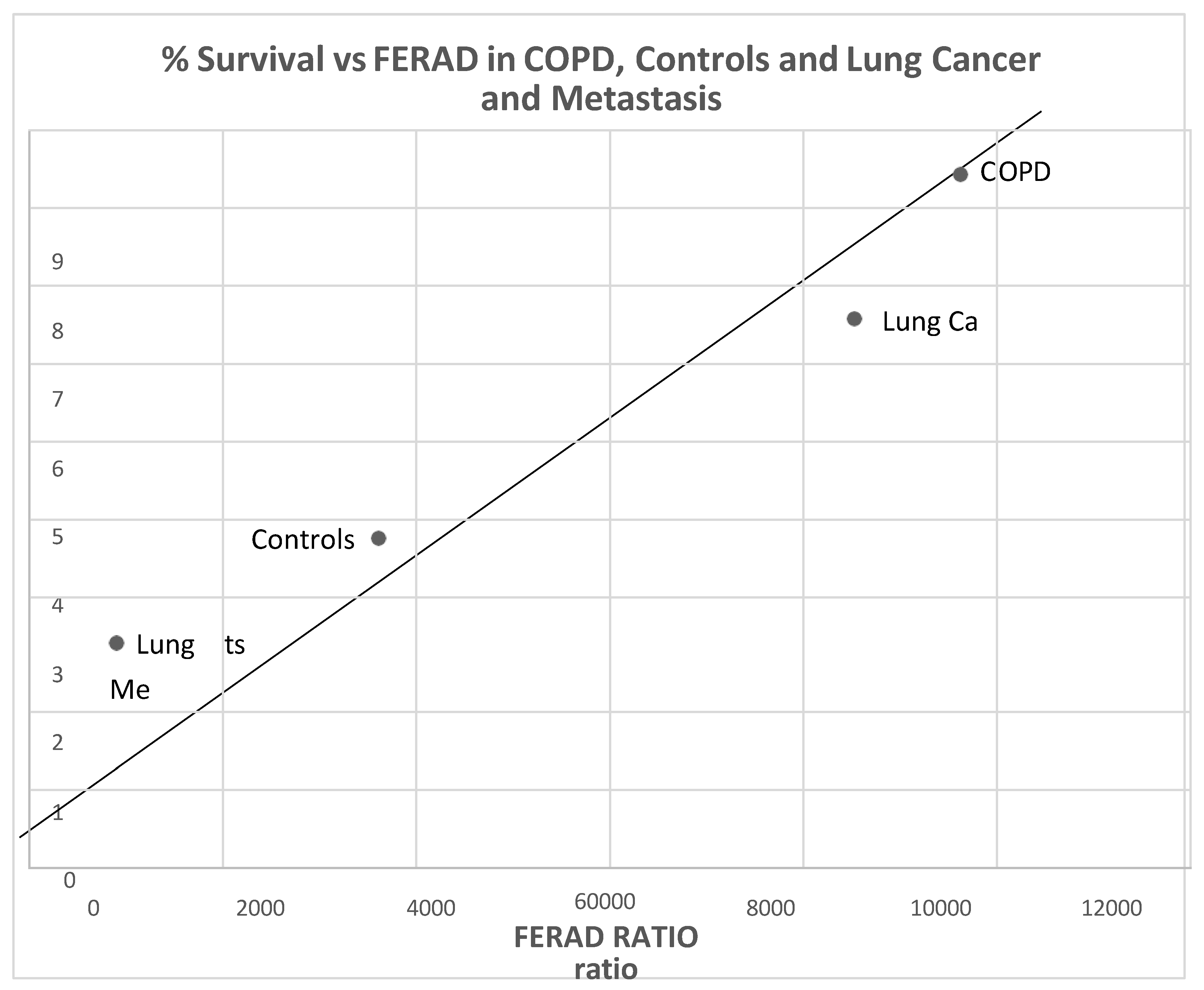
Table 1.
Demographic Table Lung Ca vs Controls.
| Parameter (n) | % Lung Cancer Cases | %Controls | Ψ2: p-VALUE |
|---|---|---|---|
| Age>50 | 77.7 | 61.7 | 2.16(1.37-3.40):<0.001 |
| Male Gender | 92.0 | 88.8 | 1.44(0.72-2.89):0.38 |
| Race black | 66.7 | 52.2 | 1.83(1.22-2.75):<0.005 |
| BMI>28 | 29.3 | 51.3 | 0.39(0.24-0.64):<0.0002 |
| FEV1>1.5L/sec | 89.5 | 83.7 | 1.66(0.37-7.53):0.55 |
| Smoking | 65.3 | 36.1 | 3.34(2.05-5.46): <0.0001 |
| Diabetes | 26.1 | 36.2 | Yates cs 3.25: :0.07 |
| No F/H cancer | 45.3 | 41.2 | Yates cs 0.53:0.47 |
| No other cancer | 18.9 | 28.5 | Yates cs 4.34:0.037 |
| Mortality | 87.5 | 61.1 | 0.23(0.13-0.40):<0.0001 |
| F/H Lung Ca | 1.9 | 0.11 | 16.69(2.33-119.70):<0.02 |
Table 2.
Comparison of Patients with stool p87 over the cutoff threshold (p87+) and below (p87-).
| Parameter | p87- Patients n=26 | p87+ Patients n=25 | p-Value |
|---|---|---|---|
| Age in years±standard deviation | 63.2±9.66 | 67.5±11.2 | p=0.149 |
| Survival (dx to death) | 10.6±4.8 years | 7.3±4.4 years | P=0.35 |
| Ferritin (ng/dL) ±standard deviation | 358±314 | 149±129 | P<0.034 |
| Native p87 cecum elisa (OD-Bg) | 0.132±0.014 | 0.055±0.031 | P<0.035 |
| Native p87 Asc.C. elisa (OD-Bg) | 0.203±0.059 | 0.042±0.023 | P<0.008 |
| FERAD ratio | 179,882±302,992 | 2,987±3492 | P<0.048 |
Table 3.
is a comparison of percentage labeling with other common Lung Cancer Antigens as previously described [11].
Table 3.
is a comparison of percentage labeling with other common Lung Cancer Antigens as previously described [11].
| Cancer Type | Adnab- 9(p87) |
TTF1(Clones) | NE Marker |
%p63/p40 | CK7 (NRecc) |
|---|---|---|---|---|---|
| Lepidic/BA | 67 | N/A | N/A | ||
| AdenoCa | 32 | 80(muc10-15) | N/A | 20-30 | 94-100 |
| Squamous | 6 | N/A | 5-77mean25% | ||
| Large Cell | 0 | 41 (9-85) | 92 | ||
| Small Cell | 22 | 79-100 | |||
| NSCLC | 15 | 10-20 | 68 | ||
| AdenoSquamous | 27 | N/A | 99 | ||
| Papillary | 74 | N/A | |||
Footnotes: NE=neuroendocrine.
Disclaimer/Publisher’s Note: The statements, opinions and data contained in all publications are solely those of the individual author(s) and contributor(s) and not of MDPI and/or the editor(s). MDPI and/or the editor(s) disclaim responsibility for any injury to people or property resulting from any ideas, methods, instructions or products referred to in the content. |
© 2024 by the authors. Licensee MDPI, Basel, Switzerland. This article is an open access article distributed under the terms and conditions of the Creative Commons Attribution (CC BY) license (http://creativecommons.org/licenses/by/4.0/).
Copyright: This open access article is published under a Creative Commons CC BY 4.0 license, which permit the free download, distribution, and reuse, provided that the author and preprint are cited in any reuse.
MDPI Initiatives
Important Links
© 2024 MDPI (Basel, Switzerland) unless otherwise stated






